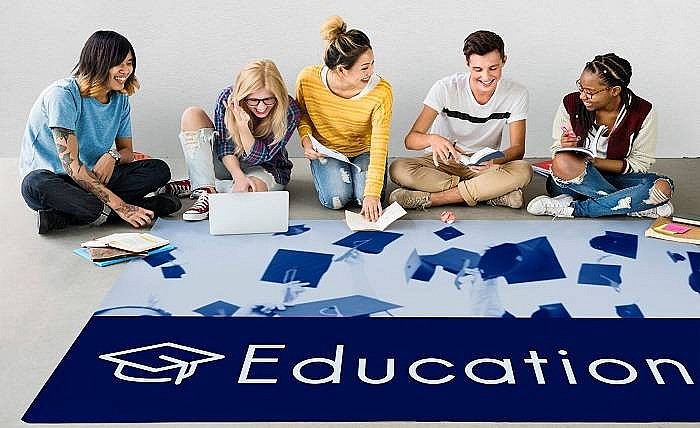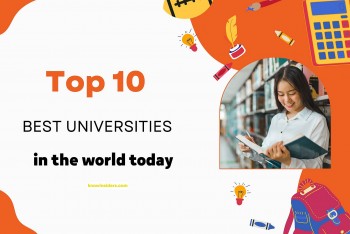Top 10 Emerging Education Trends In 2024 Worldwide
 Top 10 Emerging IT Trends That Will Rule The World 2024 Top 10 Emerging IT Trends That Will Rule The World 2024 |
 Top 10 Hottest Healthcare Trends To Rule The World In 2024 Top 10 Hottest Healthcare Trends To Rule The World In 2024 |
| Table of Contents |
Education is a dynamic area that is constantly changing to fulfill the demands of students and society. As we approach 2024, several significant educational trends are emerging that will shape the future of teaching and learning. This article will investigate these tendencies, providing insights into how education will evolve in the following years.
 |
| The Emerging Education Trends In 2024 Worldwide |
Top 10 Emerging Education Trends In 2024 Worldwide
1. Immersive Technologies and Hybrid Education
The first trend is hybrid education, which mixes online and in-person components and allows students to take classes from any location and personalize their learning. The second trend is the use of immersive technology like augmented and virtual reality to provide interesting and accessible educational experiences.
READ MORE: Education 2024 Yearly Horoscope of 12 Zodiac Signs - Astrological Forecast
2. Educational Applications of Artificial Intelligence
Artificial intelligence (AI) is transforming education by offering students with individualized learning experiences. Students can obtain individualized learning materials depending on their needs and skills by employing AI-powered content. AI-powered virtual teaching assistants are also becoming more common in educational settings, offering students with help, guidance, and feedback. Educators' grading processes are being streamlined by automated grading systems, freeing up important time for more individualized interactions with pupils. AI-powered smart content is adaptive and interactive, allowing students to learn at their own pace and in the way that best suits their learning style. Predictive analytics technologies are also being used to identify students who are at danger of falling behind in their studies and to provide targeted interventions and support.
| ChatGPT and Quantum Computing in Education Another predicted trend is the adoption of technology such as ChatGPT to aid students with learning difficulties or language problems. Quantum computing, which can identify non-obvious learning patterns and provide new views, also stands out. |
3. Educational Gamification
Gamification is gaining popularity in education as a means of increasing student engagement and motivation. Educators can make learning more interesting and participatory by introducing game components into the learning process such as challenges, prizes, and competition. Students can progress at their own pace and enjoy personalized learning experiences using adaptive learning routes on gamified platforms. In gamified environments, learning analytics give educators with useful insights on student performance and engagement, allowing them to make data-driven decisions regarding their teaching techniques and curriculum. Game-based evaluations are a more engaging and thorough way to assess student learning and progress.
READ MORE: Essential Skills and Resources for Higher Education
4. Preparing students for employment
Organizations prioritize graduates who can quickly integrate into high-performing teams, emphasizing the importance of communication and teamwork abilities.
Employers today prefer graduates who can collaborate across several work environments, smoothly moving between in-person and online communication to create strong professional relationships.
Graduates must have flexible skills such as problem-solving, critical thinking, cultural sensitivity, and resilience in addition to specialized knowledge. Employers are looking for agile, resilient learners that can quickly learn new skills, navigate complex material, and ask insightful questions in changing digital landscapes and flexible work environments.
This includes delivering a complete student experience that blends intellectual, personal, and career development initiatives for educators.
5. Improving the campus experience
The pandemic demonstrated that institutions can and should provide more than just lectures.
Embracing in-person sessions with recorded lectures for flexibility, prioritizing interactive learning, and supporting student-led social initiatives (clubs, arts, sports) to create vibrant, in-person venues for camaraderie and exploration of varied interests.
6. A shift away from established educational methods
Microschools, which are small-scale educational facilities that provide personalized learning experiences, are becoming increasingly popular. These schools frequently use new teaching techniques and offer a more intimate, community-oriented learning atmosphere. As dissatisfaction with established teaching methods rises, the rise of microschools will be a key educational trend in 2024.
Multiclassroom models, in which senior teachers supervise courses in many classrooms, are proving to be an effective strategy in addressing teacher shortages. These methods not only optimize resource utilization but also improve students' learning experiences by giving them access to skilled educators.
7. The push for educational equity
According to our findings, imminent teacher departures may disproportionately harm low-income families and pupils of color. To combat this, interventions must focus on keeping teachers in high-poverty schools, as well as those who work with both younger and older pupils.
Investing in support staff, such as full-time nurses, counselors, and special education co-teachers, can aid in the creation of a more equal learning environment. These specialists, particularly in low-income areas, can address additional problems that pupils may face, encouraging fairness in education.
8. Lifelong Learning
Each industrial revolution dramatically altered the nature of work and jobs. As great technical growth leads to changes in how individuals execute their professions, the current Fourth Industrial Revolution may affect an amazing 50% of jobs. Professionals that wish to be competitive in their field will need to regularly re-skill. They cannot expect that the education they received during the first half of their professional careers will enough for the remainder of their working life.
Rather, obtaining a degree must be followed by continued education. This necessitates institutions instilling in their students, as well as their teachers and staff, a self-development perspective. Classrooms must provide opportunity for students to gain self-learning abilities so that they can continue to learn and participate in their chosen fields.
Schools that teach these skills, on the other hand, have the opportunity to stay in touch with their graduates throughout their careers. They can provide continuing education classes that will keep their former students up to date on new advancements in their fields and ensure that they continue to return to the institution for the assistance and information they require.
9. Dealing with teacher burnout
Empowered, a non-profit organization, provides a novel approach to standard educational methods. It helps instructors by increasing their efficacy and decreasing the danger of burnout through experiential learning. Empowered could be a game changer in addressing teacher burnout, with 98% of its teachers reporting increased efficacy.
Empowered emphasizes personalized, experiential learning opportunities. It gives K-12 educators with tools, training, and community support, allowing them to deliver tailored, experience-based learning opportunities. This technique not only engages students but also energizes teachers, making teaching a more gratifying and rewarding profession.
10. Students' well-being
Students' safety and well-being remain major priorities. Universities are acutely aware of the various situations and obstacles that students, particularly international students studying abroad, may face.
Universities with a special concentration seek to offer personalized support to match each student's individual needs. For example, the University of Sydney provides swimming lessons to students so that they can enjoy Australia's beautiful beaches safely.
Conclusion
Aside from edtech developments, we can observe that psychological health of both teachers and students is becoming more important in 2024, with major rising educational trends all over the world. The relationship between teachers and students will grow more vital in a world dominated by technology.
 Top 10 Most Prestigious Universities In The World by Times Higher Education Top 10 Most Prestigious Universities In The World by Times Higher Education Which university in the world is the best and most prestigious? You're probably thinking of some well-known people. Take a look at our list down ... |
 10 Best Online Learning Platforms For Elementary Students 10 Best Online Learning Platforms For Elementary Students Which online learning environments are most suitable for elementary school students? See which are the most helpful, as determined by Knowinsiders.com's 2024 ranking. |
 Top 10+ Best Countries For Education (2024) Top 10+ Best Countries For Education (2024) Which nation has the best educational system? There is always controversy surrounding the response. We use the most recent indications to update the rankings below. |



























